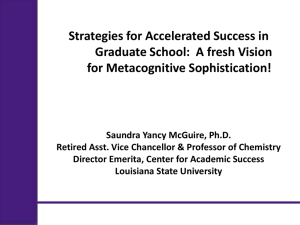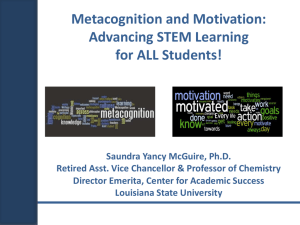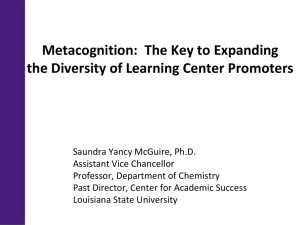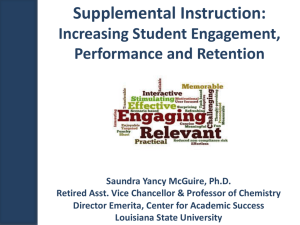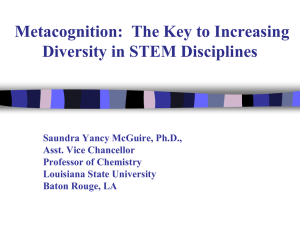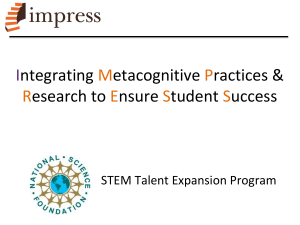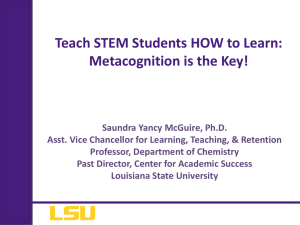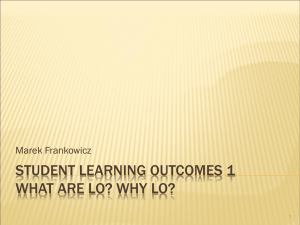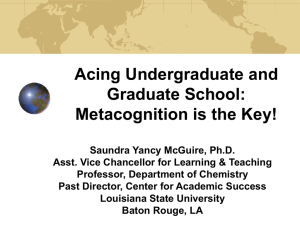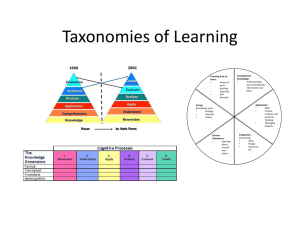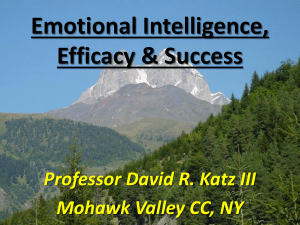HOW I LEARN - (SERP) Institute
advertisement
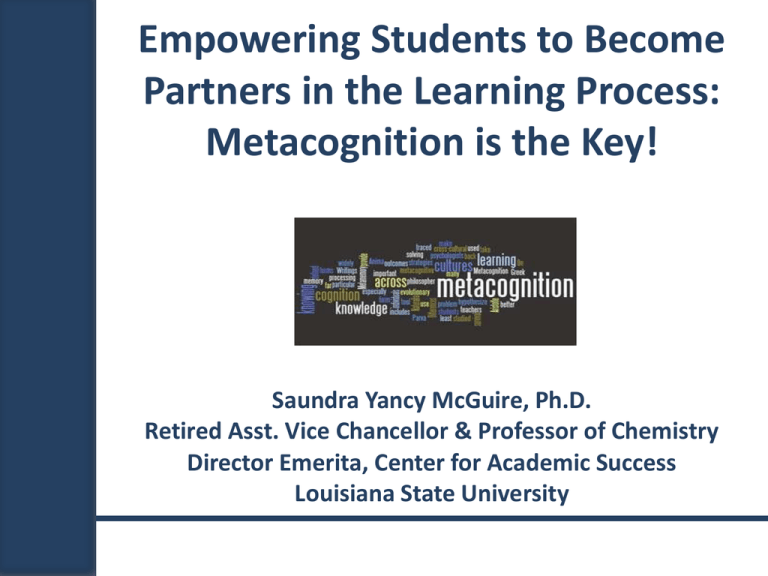
Empowering Students to Become Partners in the Learning Process: Metacognition is the Key! Saundra Yancy McGuire, Ph.D. Retired Asst. Vice Chancellor & Professor of Chemistry Director Emerita, Center for Academic Success Louisiana State University PULSE Charge To inspire whole departments to undertake the reforms called for in Vision and Change in Undergraduate Biology Education: A Call to Action and to support those efforts The ultimate goal for biology departments should be to develop and grow communities of scholars at all levels of the educational process — from undergraduates to faculty to administrators — all committed to creating, using, assessing, and disseminating effective practices in teaching and learning Metacognition: The Key to Learning The ability to: think about one’s own thinking be consciously aware of oneself as a problem solver monitor, plan, and control one’s mental processing (e.g. “Am I understanding this material, or just memorizing it?”) accurately judge one’s level of learning Flavell, J. H. (1976). Metacognitive aspects of problem solving. In L. B. Resnick (Ed.), The nature of intelligence (pp.231-236). Hillsdale, NJ: Erlbaum Why haven’t most students developed metacognitive skills? It wasn’t necessary in high school http://www.heri.ucla.edu/ Faculty Must Help Students Make the Transition to College Help students identify and close “the gap” current behavior current grades productive behavior desired grades Turn Students into Expert Learners: Teach Them Metacognitive Learning Strategies! Reflection Questions • What’s the difference, if any, between studying and learning? • For which task would you work harder? A. Make an A on the test B. Teach the material to the class For which task would you work harder? 93% 1. Make an A 2. Teach the material 7% 1 2 The Story of Two Students Travis, junior psychology student 47, 52, 82, 86 B in course Dana, first year physics student 80, 54, 91, 97, 90 (final) A in course Travis, junior psychology student 47, 52, 82, 86 Problem: Reading Comprehension Solution: Preview text before reading* Develop questions* Read one paragraph at a time and paraphrase information *Develop anticipatory set First Voyage of Christopher Columbus WITH HOCKED GEMS FINANCING HIM/ OUR HERO BRAVELY DEFIED ALL SCORNFUL LAUGHTER/ THAT TRIED TO PREVENT HIS SCHEME/ YOUR EYES DECEIVE/ HE HAD SAID/ AN EGG/ NOT A TABLE/ CORRECTLY TYPIFIES THIS UNEXPLORED PLANET/ NOW THREE STURDY SISTERS SOUGHT PROOF/ FORGING ALONG SOMETIMES THROUGH CALM VASTNESS/ YET MORE OFTEN OVER TURBULENT PEAKS AND VALLEYS/ DAYS BECAME WEEKS/ AS MANY DOUBTERS SPREAD FEARFUL RUMORS ABOUT THE EDGE/ AT LAST/ FROM NOWHERE/ WELCOME WINGED CREATURES APPEARED/ SIGNIFYING MOMENTOUS SUCCESS Dooling, J.D. and Lachman, R. Effects of Comprehension on Retention of Prose, Journal of Experimental Psychology, (1971), Vol. 88, No. 2, 216-222 Anticipatory set CAN interfere! Let’s look at the car on the next slide… Is this a 2-door or 4-door car? Dana, first year physics student 80, 54, 91, 97, 90 (final) Problem: Memorizing formulas and using online homework aids Solution: Solve problems with no external aids and test mastery of concepts Online Homework Can be a great learning tool Can be a detriment to student learning if used incorrectly Should be discussed in terms of effective learning strategies Why Can Students Make Such a Fast and Dramatic Increase? It’s all about the strategies! Counting Vowels in 45 seconds How accurate are you? Count the vowels in the words on the next slide. Dollar Bill Dice Tricycle Four-leaf Clover Hand Six-Pack Seven-Up Octopus Cat Lives Bowling Pins Football Team Dozen Eggs Unlucky Friday Valentine’s Day Quarter Hour How many items on the list do you remember? 1. 2. 3. 4. 5. 6. 0-1 2–5 6–8 9 – 11 12 – 14 15 58% 29% 8% 1 5% 2 3 4 0% 0% 5 6 Let’s look at the words again… What are they arranged according to? Dollar Bill Dice Tricycle Four-leaf Clover Hand Six-Pack Seven-Up Octopus Cat Lives Bowling Pins Football Team Dozen Eggs Unlucky Friday Valentine’s Day Quarter Hour NOW how many words or phrases do you remember? 1. 2. 3. 4. 5. 6. 0-1 2–5 6–8 9 – 11 12 – 14 15 43% 40% 9% 6% 3% 0% 1 2 3 4 5 6 What were two major differences between the 1st and 2nd attempts? 1. We knew what the task was 2. We knew how the information was organized An Excellent Introduction Bransford, J.D., Brown, A.L., Cocking, R.R. (Eds.), 2000. How people learn: Brain, Mind, Experience, and School. Washington, DC: National Academy Press. What we know about learning • Active learning is more lasting than passive learning -- Passive learning is an oxymoron* • Thinking about thinking is important – Metacognition** • The level at which learning occurs is important – Bloom’s Taxonomy*** *Cross, Patricia, “Opening Windows on Learning” League for Innovation in the Community College, June 1998, p. 21. ** Flavell, John, “Metacognition and cognitive monitoring: A new area of cognitive– developmental inquiry.” American Psychologist, Vol 34(10), Oct 1979, 906-911. *** Bloom Benjamin. S. (1956). Taxonomy of Educational Objectives, Handbook I: The Cognitive Domain. New York: David McKay Co Inc. Bloom’s Taxonomy Anderson & Krathwohl, 2001 http://projects.coe.uga.edu/epltt/index.php?title=Bloom's_Taxonomy Bloom’s Taxonomy Making judgments based on criteria and standards through checking and critiquing. This pyramid depicts the different levels of thinking we use when learning. Notice how each level builds on the foundation that precedes it. It is required that we learn the lower levels before we can effectively use the skills above. Creating Evaluating Analyzing Carrying out or using a procedure through executing, or implementing. Breaking material into constituent parts, determining how the parts relate to one another and to an overall structure . Applying Understanding Retrieving, recognizing, and recalling relevant knowledge from long-term memory. Putting elements together to form a coherent or functional whole; reorganizing elements into a new pattern or structure through generating, planning, or producing. Constructing meaning from oral, written, and graphic messages through interpreting, exemplifying, classifying, summarizing, inferring, comparing, and explaining. Remembering http://www.odu.edu/educ/llschult/blooms_taxonomy.htm When we teach students about Bloom’s Taxonomy… They GET it! How do you think students answered? At what level of Bloom’s did you have to operate to make A’s or B’s in high school? 76% 1. 2. 3. 4. 5. 6. Remembering Understanding Applying Analyzing Evaluating Creating 22% 3% 1 2 3 0% 0% 0% 4 5 6 How students answered (2008) At what level of Bloom’s did you have to operate to make A’s or B’s in high school? 1. 2. 3. 4. 5. 6. Remembering Understanding Applying Analyzing Evaluating Creating 35% 25% 21% 13% 1 2 3 4 3% 3% 5 6 How students answered (2013) At what level of Bloom’s did you have to operate to make A’s or B’s in high school? 44% 1. 2. 3. 4. 5. 6. Remembering Understanding Applying Analyzing Evaluating Creating 29% 21% 4% 0% 1 2 3 4 5 2% 6 How students answered (2014) At what level of Bloom’s did you have to operate to make A’s and B’s in high school? 36% 1. 2. 3. 4. 5. 6. Remembering Understanding Applying Analyzing Evaluating Creating 28% 25% 8% 3% 0% 1 2 3 4 5 6 How do you think students answered? At what level of Bloom’s do you think you’ll need to operate to make A’s in college courses? 35% 1. 2. 3. 4. 5. 6. Remembering Understanding Applying Analyzing Evaluating Creating 30% 18% 13% 5% 0% 1 2 3 4 5 6 How students answered (in 2008) At what level of Bloom’s do you think you’ll need to operate to make an A’s in college? 1. 2. 3. 4. 5. 6. Remembering Understanding Applying Analyzing Evaluating Creating 35% 23% 15% 14% 7% 6% 1 2 3 4 5 6 How students answered (in 2013) At what level of Bloom’s do you think you’ll need to operate to make A’s in college? 1. 2. 3. 4. 5. 6. Remembering Understanding Applying Analyzing Evaluating Creating 40% 23% 11% 11% 9% 6% 1 2 3 4 5 6 How students answered (in 2014) At what level of Bloom’s do you think you’ll need to operate to make A’s in college? 46% 1. 2. 3. 4. 5. 6. Remembering Understanding Applying Analyzing Evaluating Creating 27% 12% 7% 7% 2 3 0% 1 4 5 6 How do we teach students to move higher on Bloom’s Taxonomy? Teach them the Study Cycle* *adapted from Frank Christ’s PLRS system The Study Cycle 344 Reflect Review Reflect Preview Preview before class – Skim the chapter, note headings and boldface words, review summaries and chapter objectives, and come up with questions you’d like the lecture to answer for you. Attend Attend class – GO TO CLASS! Answer and ask questions and take meaningful notes. Review Review after class – As soon after class as possible, read notes, fill in gaps and note any questions. Study Assess Study – Repetition is the key. Ask questions such as ‘why’, ‘how’, and ‘what if’. • Intense Study Sessions* - 3-5 short study sessions per day • Weekend Review – Read notes and material from the week to make connections Assess your Learning – Periodically perform reality checks • Am I using study methods that are effective? • Do I understand the material enough to teach it to others? Intense Study Sessions Decide what you want to accomplish in your study session 1 Set a Goal 2 Study with Focus 30-50 min Interact with material- organize, concept map, summarize, process, re-read, fill-in notes, reflect, etc. 3 Reward Yourself 10-15 min Take a break– call a friend, play a short game, get a snack 4 Review 1-2 min 5 min Go over what you just studied Center for Academic Success B-31 Coates Hall ▪ 225.578.2872 ▪www.cas.lsu.edu Metacognitive Get Acquainted Activity* • What do you believe is important to understand and learn in _____________________? • What do you believe to be critical characteristics of successful students in ___________? • How will you study and prepare for exams in ______________________________? *Simpson, M. & Rush, L. (2012) in Teaching Study Strategies in Developmental Education, Hodges, Simpson, Stahl eds. New York: Bedford/St. Martin’s Two Valuable References Gabriel, Kathleen F. (2008) Teaching Unprepared Students. Sterling, VA: Stylus Publishing Nilson, Linda. (2013) Creating Self-regulated Learners Sterling, VA: Stylus Publishing February 7, 2010 Chronicle of Higher Education How Students Can Improve by Studying Themselves Researchers at CUNY's Graduate Center push 'self-regulated learning' Grazyna Niezgoda, a math instructor at New York City College of Technology, says most students eventually appreciate the new methods. Help Students Develop the Right Mindset Dweck, Carol, 2006. Mindset: The New Psychology of Success. New York: Random House Publishing Shenk, David, 2010. The Genius in All of Us: Why Everything You've Been Told About Genetics, Talent, and IQ Is Wrong. New York: Doubleday Mindset* is Important! Fixed Intelligence Mindset Intelligence is static You have a certain amount of it Growth Intelligence Mindset Intelligence can be developed You can grow it with actions Dweck, Carol (2006) Mindset: The New Psychology of Success. New York: Random House Publishing Responses to Many Situations are Based on Mindset Fixed Intelligence Mindset Response Growth Intelligence Mindset Response Challenges Avoid Embrace Obstacles Give up easily Persist Tasks requiring effort Fruitless to Try Path to mastery Ignore it Learn from it Threatening Inspirational Criticism Success of Others Innovative Educators Webinar October 20, 2010 Which mindset about intelligence do you think most students have? 1. Fixed 2. Growth 83% 17% 1 2 Which mindset about intelligence do you think most faculty have? 53% 1. Fixed 2. Growth 48% 1 2 Which mindset about intelligence do you think most STEM faculty have? 1. Fixed 2. Growth 68% 32% 1 2 Email from a Spring 2011 General Chemistry Student “…Personally, I am not so good at chemistry and unfortunately, at this point my grade for that class is reflecting exactly that. I am emailing you inquiring about a possibility of you tutoring me.” April 6, 2011 --------------------------------------------------------------------------------------------------------------------------------------------“I made a 68, 50, (50), 87, 87, and a 97 on my final. I ended up earning a 90 (A) in the course, but I started with a 60 (D). I think what I did different was make sidenotes in each chapter and as I progressed onto the next chapter I was able to refer to these notes. I would say that in chemistry everything builds from the previous topic. May 13, 2011 Semester GPA: 3.8 What happens when we teach metacognitive learning strategies, Bloom’s Taxonomy, and the Study Cycle to an entire class, not just individuals? Performance in Gen Chem I in 2011 Based on One Learning Strategies Session Exam 1 Avg.: Exam 2 Avg.: Final course Avg*.: Final Course Grade: Attended 71.65% 77.18% 81.60% Absent 70.45% 68.90% 70.43% B C The one 50-min presentation on study and learning strategies resulted in an improvement of one full letter grade! Metacognition: An Effective Tool to Promote Success in College Science Learning* Ningfeng Zhao1, Jeffrey Wardeska1, Saundra McGuire2, Elzbieta Cook2 1Department of Chemistry, East Tennessee State University 2Department of Chemistry, Louisiana State University *March/April 2014 issue of JCST, Vol. 43, No. 4, pages 48-54 Teaching and Learning Strategies That Work SCIENCE , VOL 325 4 SEPTEMBER 2009 www.sciencemag.org ROALD HOFFMANN1* AND SAUNDRA Y. MCGUIRE2 1Department of Chemistry and Chemical Biology, Cornell University, Baker Laboratory, Ithaca, NY 14853, USA. 2Center for Academic Success and Department of Chemistry, Louisiana State University, Baton Rouge, LA 70803, USA. September-October 2010 Volume 98, Number 5 MARGINALIA Learning and Teaching Strategies Roald Hoffmann and Saundra Y. McGuire Sharing Strategies that Have Worked for Others Can Be Very Motivational Top 5 Reasons Students Did Not Do Well on Test 1 in General Chemistry 1. Didn’t spend enough time on the material 2. Started the homework too late 3. Didn’t memorize the information I needed to memorize 4. Did not use the book 5. Assumed I understood information that I had read and re-read, but had not applied Top 5 Reasons Students Made an A on Test 1: 1. Did preview-review for every class 2. Did a little of the homework at a time 3. Used the book and did the suggested problems 4. Made flashcards of the information to be memorized 5. Practiced explaining the information to others Email from ENG Professor at New Mexico State Univ. Received on 10/22/2013 At the end of a 60 minute learning strategies presentation by the professor, students were given a survey to determine their self-assessment of whether they were using or not using the strategies. The average scores of the different groups on the first two exams are shown below. Self-Reported Use of Strategies Exam 1 Exam 2 Did not use the strategies 58 54 Used metacognitive strategies 95 80 Changes Faculty Have Made that Improved Learning and Performance • Provide learning strategies information to students after Test 1, and tell them about mindset (Psychology Professor at Southern Crescent Technical College, 2013) • Increase the frequency of tests from three per semester to biweekly (Mathematics Professor at Miles College, 2013) • Have students determine their learning style and write reflection on how they will use the information (Entomology Professor at LSU, 2009) • Present one 50 minute session on metacognition, Bloom’s Taxonomy, and the Study Cycle (Chemistry Professor at Middle Tennessee State University, 2012) • Teach students how to read (Chemistry Professor at LSU, 2004) The Impact of Using Metacognitive Strategies I'm so happy you emailed me ! I'm also happy to let you know that I finished the semester with a 4.0 GPA :)! I finished both calc and chem with an A. I earned a 96 A on my chem final after some hard studying, and an A on my calc final as well. Your tips and encouragement were definitely a factor in my success! Thank you soooooo much ! I am also enrolled in Dr. Cook's chemistry 1422 course for the upcoming spring semester! So I'm excited to utilize your tips for Dr. Cook's class and for the rest of my college career. Fall 2013 First semester honors chemistry student LSU Analytical Chemistry Graduate Student’s Cumulative Exam Record 2004 – 2005 2005 – 2006 9/04 Failed 10/05 Passed 10/04 Failed 11/05 Failed 12/05 Passed best in group 1/06 Passed 2/06 Passed Began work with CAS and the Writing Center in October 2005 11/04 Failed 12/04 Failed 1/05 Passed 2/05 Failed 3/06 Failed 3/05 Failed 4/06 Passed last one! 4/05 Failed 5/06 N/A Dr. Algernon Kelley, December 2009 From a Xavier University student to Dr. Kelley in Fall 2011 Oct. 17, 2011 Hello Dr. Kelley. … I am struggling at Xavier and I REALLY want to succeed, but everything I've tried seems to end with a "decent" grade. I’m not the type of person that settles for decent. What you preached during the time you were in Dr. Privett's class last week is still ringing in my head. I really want to know how you were able to do really well even despite your circumstances growing up. I was hoping you could mentor me and guide me down the path that will help me realize my true potential while here at Xavier. Honestly I want to do what you did, but I seriously can't find a way how to. Can I please set up a meeting with you as soon as you’re available so I can learn how to get a handle grades and classes? Oct. 24, 2011 Hey Dr. Kelley, I made an 84 on my chemistry exam (compared to the 56 on my first one) using your method for 2 days (without prior intense studying). Thanks for pointing me in the right direction. I’ll come by your office Friday and talk to you about the test. Nov 3, 2011 Hey Dr. Kelley! I have increased my Bio exam grade from a 76% to a 91.5% using your system. Ever since I started your study cycle program, my grades have significantly improved. I have honestly gained a sense of hope and confidence here at Xavier. My family and I are really grateful that you have taken time to get me back on track. Knowledge of Metacognition Greatly Increases URM Student Success They are less likely to have been cognitively challenged in high school They are more likely to feel that they don’t belong* They are more likely to think that initial failure means they are not “smart” enough and become victims of stereotype threat* They are more likely to feel that the other students and the professor do not respect them* *Aguilar, L., Walton, G., Wieman, C.. Physics Today 67(5), 43 (2014); doi: 10.1063/PT.3.2383 Social Psychologists Address These Barriers Physics Today 67(5), 43 (2014); doi: 10.1063/PT.3.2383 www.stanford.edu/~gwalton/home/Welcome_files/AguilarWaltonWieman2014.pdf Small Interventions Yield Big Improvements Physics Today 67(5), 43 (2014); doi: 10.1063/PT.3.2383 www.stanford.edu/~gwalton/home/Welcome_files/AguilarWaltonWieman2014.pdf Does this method work for all students? Categories of students for whom it generally does not work 1. Students who refuse to take any personal responsibility for anything 2. Students who have no time to implement the strategies 3. Students for whom the gap is too large between the level of skills required for the course and the level of skills acquired prior to entering the course BUT, when we know the barriers, they can be addressed! What do all the studies tell us? We can significantly increase learning by… • • • • teaching students how to learn making learning visible making the implicit explicit not judging student potential on initial performance • Implementing small interventions to address psychological factors • encouraging the use of metacognitive tools • supporting the campus learning center! Final Reflection Questions: Who is primarily responsible for student learning? 86% 1. The student 2. The professor 3. The institution 11% 3% 1 2 3 Who do students say is primarily responsible for student learning? 98% 1. The student 2. The professor 3. The institution 3% 0% 1 2 3 The reality is that… when all three of these entities take full responsibility for student learning, we will experience a significant increase in student learning, grades, retention, graduation rates, and achievement of SERP and PULSE goals! Special Note Please visit the CAS website at www.cas.lsu.edu. We have on-line workshops that will introduce you and your students to effective metacognitive strategies. Please feel free to contact me at smcgui1@lsu.edu. Have fun teaching your students powerful metacognitive strategies! Saundra McGuire Useful Websites • • • • • www.cas.lsu.edu www.howtostudy.org www.vark-learn.com www.drearlbloch.com Searches on www.google.com Additional References • Bruer, John T. , 2000. Schools For Thought: A Science of Learning in the Classroom. MIT Press. • Bransford, J.D., Brown, A.L., Cocking, R.R. (Eds.), 2000. How people learn: Brain, Mind, Experience, and School. Washington, DC: National Academy Press. • Christ, F. L., 1997. Seven Steps to Better Management of Your Study Time. Clearwater, FL: H & H Publishing • Cromley, Jennifer, 2000. Learning to Think, Learning to Learn: What the Science of Thinking and Learning Has to Offer Adult Education. Washington, DC: National Institute for Literacy. • Ellis, David, 2006. Becoming a Master Student*. New York: Houghton-Mifflin. • Hoffman, Roald and Saundra Y. McGuire. (2010). Learning and Teaching Strategies. American Scientist , vol. 98, pp. 378-382. • Nilson, Linda, 2004. Teaching at Its Best: A Research-Based Resource for College Instructors. Bolton, MA: Anker Publishing Company. • Pierce, William, 2004. Metacognition: Study Strategies, Monitoring, and Motivation. http://academic.pg.cc.md.us/~wpeirce/MCCCTR/metacognition.htm *Excellent student reference Acknowledgments • Sarah Baird & LSU Center for Academic Success • Prof. Isiah Warner, Dr. Zakiya Wilson and the LSU Office of Strategic Initiatives • Dr. Elzbieta Cook, LSU General Chem Instruct • National College Learning Center Association • Prof. Roald Hoffmann, mentor and collaborator • All of the faculty who implemented these strategies and provided feedback • All of the students who changed their attitudes and behaviors and showed me what was possible!
